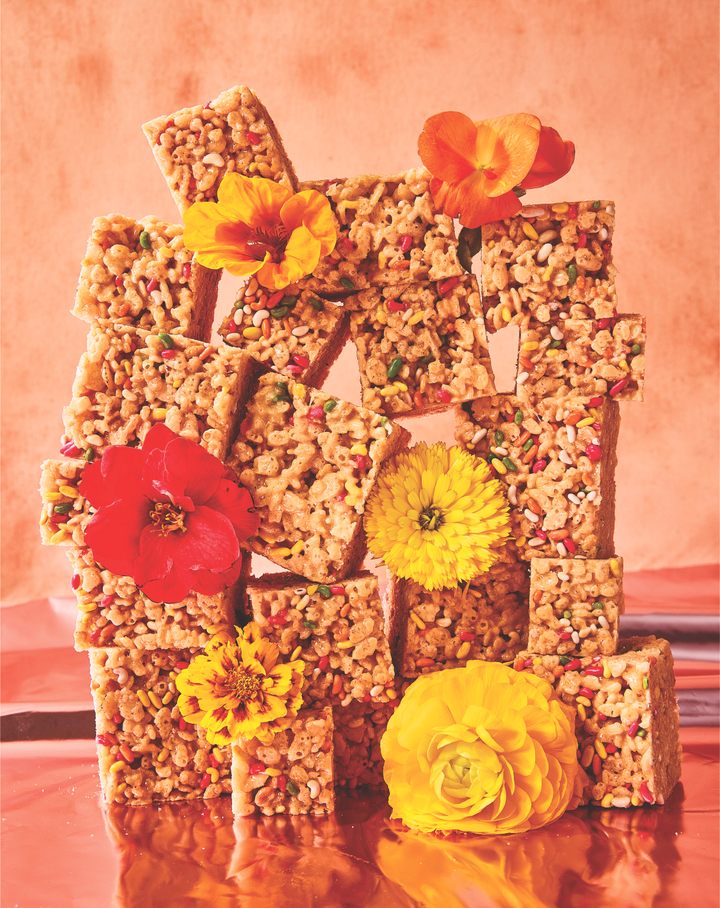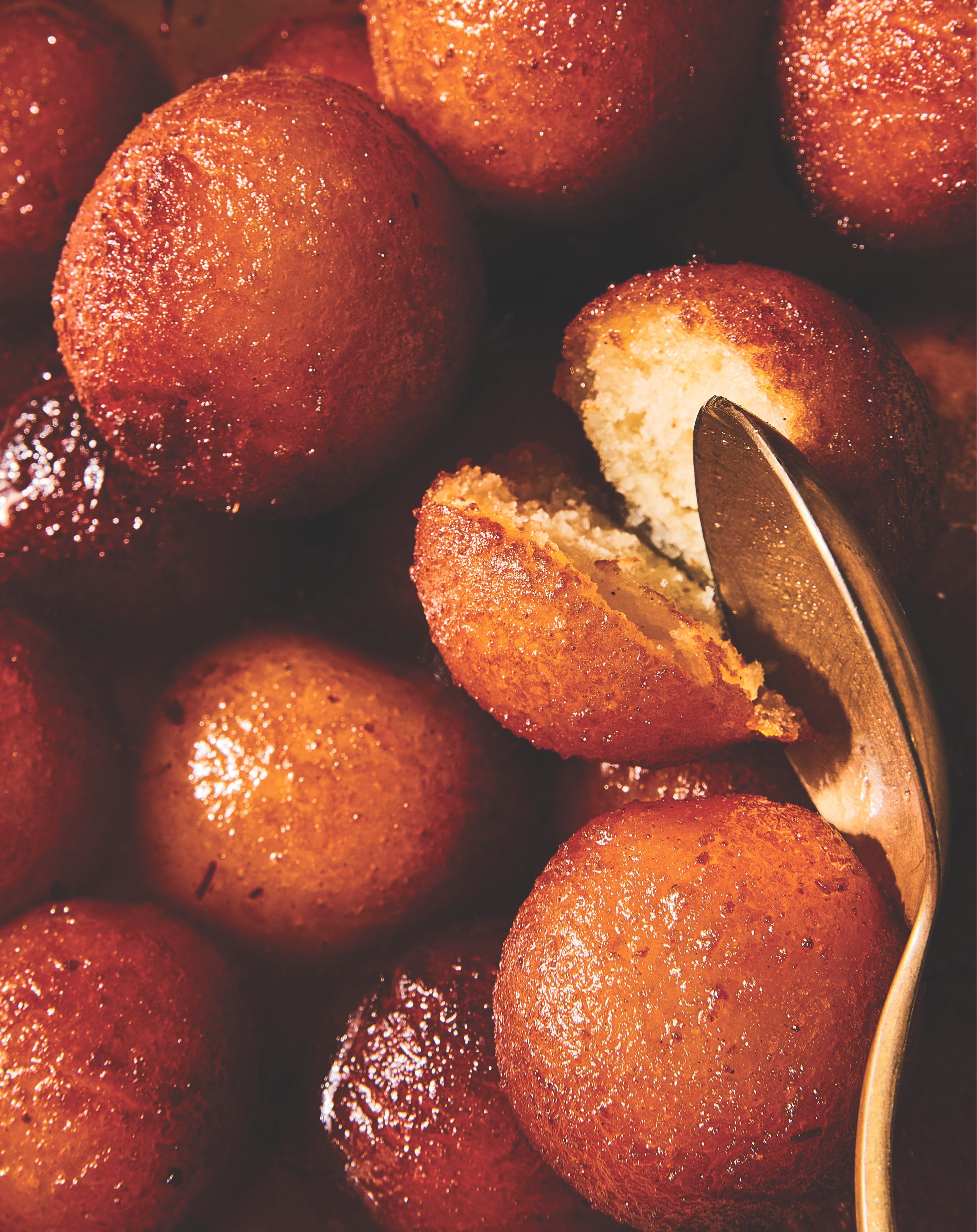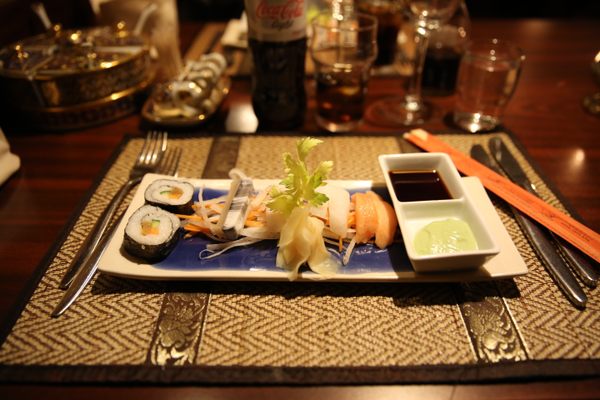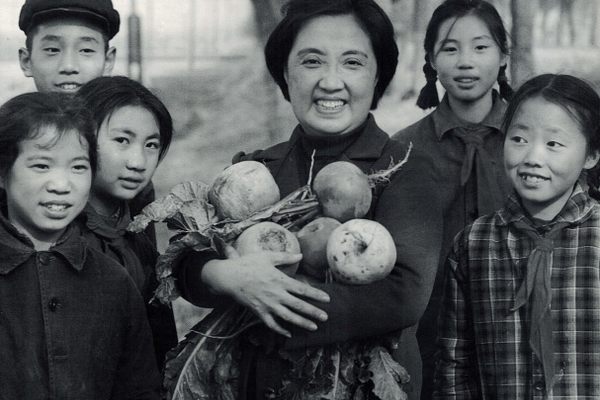

A Cookbook That Celebrates Indian American Ingenuity
When life gives you Bisquick, make gulab jamun.
With online shopping providing the rarest, most far-flung ingredients at the click of a button these days, it’s easy to forget how challenging cooking in a diaspora once was. Khushbu Shah hasn’t forgotten. She remembers watching her mother in their Michigan kitchen, working wonders to make the dishes of her native Gujarat, India, with a limited American pantry in the 1980s and ’90s.
One of her favorite treats was gulab jamun, doughnuts soaked in saffron syrup, with a distinctly American twist. In place of khoya—slowly boiled-down milk that was impossible to buy premade in the U.S. and laborious to make from scratch—her mother reached for Bisquick. Combined with dried milk powder, the baking mix produced a fluffy texture in the gulab jamun that Shah swears is “even better than the traditional version.”
But that wasn’t the only savvy substitution made in the Shah family kitchen. There were recreations of upma porridge that swapped semolina for Cream of Wheat; chevvdo snack mixes that replaced fried lentils and flattened rice with breakfast cereals like Rice Chex and Froot Loops; and samosa wrappers fashioned from tortillas, dumpling wrappers, and white sandwich bread.
As Shah writes in her new cookbook, Amrikan: 125 Recipes from the Indian American Diaspora, adaptation is “the main ingredient in the Indian American culinary lexicon.” The cookbook celebrates the creativity of Indian American cooks like her mother, whose ingenuity inspired Shah to pursue a career as a food writer and editor. Along with recipes for the foods she grew up eating, Shah shares new Indian American delights of her own, like masala chai Basque cheesecake, tandoori vegetable supreme pizza, and Rice Krispie treats with jaggery and candied fennel seeds.
Gastro Obscura spoke with Shah about resourcefulness, why saag sauce belongs on lasagna, and how her parents are coping with their newfound fame.

The book is so joyfully personal, with your family’s recipes, stories, and photos. How have they reacted to it?
I think for the most part, they’re really excited, and they find it to be really fun. My dad is such a ham and walks around the book backwards so that you just see his face [in a photo on the back cover]. He will sign your book for you and it’s, like, a four-part signature. It’s the funniest thing.
My mom, meanwhile, hates the cover, doesn’t think the back is funny, and has all these opinions on certain recipes. But at the same time, I think she actually thinks it’s pretty cool to have a lot of these recipes written down. Once, I overheard her talking to my aunt, being like, “I never understood why she wanted to sit here and make me measure everything. It was so annoying.” But then she said, “You know what? It’s really nice to have it all written down in one place. And every single time this recipe works out.”
It’s the highest compliment when my mom or my aunt makes a recipe I came up with. My mom really loves the saag paneer lasagna. I made it for Thanksgiving last year, and she looked at me and goes, “Khushbu, this is actually good.” I was like, Wow. That’s it. I don’t need any other blurbs for the book.
It makes sense your mom has such strong opinions about the book because she’s all over it. Your dad’s on the back cover, but it seems like your mother was the most influential when it comes to your passion for cooking.
The whole thesis of this book was inspired by the way that she cooks, this idea of adaptation and just working with what you have and not being afraid to use the occasional shortcut. There’s no shame in that if it means that you’re going to get this dish on the table.
She has all kinds of tips and tricks up her sleeve that I don’t think she realizes are brilliant hacks—even if they seem crazy to people, like straining yogurt between bath towels.

Let’s talk about your own recipes and adaptations. Was there a lot of R&D involved in creating recipes for the book?
There was a solid amount of development. It was all things that I wanted to see in the world, or inspired by other things I had seen, or based off of the global pantry that I tend to cook with.
So I love boba, especially living in L.A. It’s amazing and I love that chewy element that’s missing in a lot of Indian desserts for me. Like falooda, which is traditionally made with vermicelli noodles and bloomed basil. I never have basil seeds on hand, but I always have chia seeds. And I don’t always have vermicelli, but I do always have rice noodles and I like the texture of rice noodles better, quite frankly. So I was like, This dish has always been missing boba, and I started throwing it into mine. And that’s how [the recipe for] Bobalooda came about.
The saag paneer lasagna was an idea that came to me as I was thinking about the book. I’m very particular about lasagna. I really hate when they’re super wet, gloopy, ricotta-y. My favorite kind is a spinach lasagna with a béchamel. I thought, That’s not that far away from a saag sauce. I wonder why no one has done this. So I did a three-day internet deep dive—Pinterest, TikTok … I could not find any version of it, which was crazy to me. I made it for a dinner party, and it was such a hit. I was like, Okay, this has to go in the book. Because lasagna, to me, is also such a staple of dinner parties or holidays—Thanksgiving, Christmas—so it made a lot of sense to include one that had this Indian American spin.

It’s clear that Indian American food is super fun and joyful and creative in a way all its own. So as I was reading, I thought, why don’t I see more Indian American restaurants?
When you really look at the waves of immigration in the U.S., there’s a reason why there’s this idea that all the Indians are doctors, lawyers, engineers … It’s because, in many ways, they are. The wave of immigration here was people pursuing professional degrees. Food and restaurants and stuff are unfortunately considered blue-collar work. Even though it’s incredible work and important work, it’s not necessarily encouraged so much in the culture for people to be opening restaurants.
I’m hoping that will start to change. You’re starting to see some shifts, even in our generation. The fact that I’m speaking to you today is a shift. I’m a writer by profession. And there’s a lot more South Asian creatives that are starting to come up in this space. We’re starting to see some more South Asian or Indian American restaurants pop up, too, like Pijja Palace in L.A.
So I’m hopeful that this wave will continue and that there’s more Indian Americans that are encouraged to get into the industry and make the food that really matters to them.

So the book is mostly about the importance of adaptation and the amazing dishes that result, but one line in your intro really grabbed me. It says, “In a diaspora, adaptation also means finding ways to hold on.” What is it about those dishes that makes it important to keep them as is, versus adapting?
I think food is often the final bridge that people have to culture, or it’s the first bridge you’re able to build back. And there’s something really magical and incredible about that. But those bridges are often rooted in these classic baseline dishes that taste the same in their home as they do in diaspora. There’s certain pillar dishes, certain dahls, certain lentil-based dishes, things like that that just speak to the ethos of how a culture likes to cook.
Sure, you can go on to eventually adapt and tweak it however you want, but preserving that core recipe is the foundation of these bridges.
This interview has been edited and condensed for clarity.
Gulab Jamun
Makes 36 to 40 pieces
Chasni (Syrup)
20 to 25 saffron threads
3 1/2 cups sugar
3 cups water
1 tablespoon rose water
Jamun
Neutral oil, for frying
2 cups dry milk powder
1 cup Bisquick
1 teaspoon ground cardamom
2 cups heavy cream
1. In a small bowl, microwave the saffron for 25 seconds. This will dry it out to make it easier to break up the threads.
2. Combine the sugar and water in a medium saucepan over medium heat and stir until the sugar dissolves.
3. Crush the saffron between your fingers and add it to the pan. Turn the heat up to high and bring the mixture to a boil. Boil for 2 minutes, then remove the pan from the heat and add the rose water. Set the syrup aside to cool to room temperature.
4. While the syrup cools, make the jamun. In your favorite deep-frying vessel, heat 3 to 4 inches of oil until it hits 350 degrees F.
5. In a medium bowl, mix the milk powder, Bisquick, and cardamom until evenly combined. Add the cream and bring the dough together with a spoon or with your hands until it forms a smooth, soft ball that doesn’t crack. (If the dough feels dry, you can add water, a teaspoon at a time, until it reaches the desired consistency.) The dough should be soft, but it shouldn’t stick to your hands. If it does stick, add a little more milk powder.
6. Pinch off 1-inch balls of dough and roll between your palms until smooth. Set aside on a plate and cover with a kitchen towel. You should have 36 to 40 balls.
7. Drop 3 or 4 dough balls into the hot oil. Bubbles should form around the dough as soon as you drop them in. Using a slotted spoon, keep turning the jamun until they are evenly brown and golden on all sides, 2 to 3 minutes. If they brown faster than that, you need to drop the temperature of your oil. Using a slotted spoon, transfer the jamun to a plate lined with paper towels. Repeat until all the jamun are fried.
8. Once they are slightly cooled, add the jamun to the syrup mixture. Make sure each jamun is submerged in the syrup. Let soak for 4 to 6 hours at room temperature before serving.
Gulab jamun are ridiculously good cold out of the fridge, at room temperature, or after being warmed up in the microwave for 30 seconds. On the off chance you do have any leftovers, gulab jamun freeze incredibly well. Just thaw and heat up in the microwave when the craving strikes.
Gastro Obscura covers the world’s most wondrous food and drink.
Sign up for our regular newsletter.















Follow us on Twitter to get the latest on the world's hidden wonders.
Like us on Facebook to get the latest on the world's hidden wonders.
Follow us on Twitter Like us on Facebook